|
| |
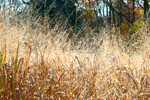 
The Natural Resources Conservation Service —
Helping People Help the Land.
Subscribe to NRCS This Week
| NRCS This Week Articles Index | NRCS
This Week Archives |
Contact Us |
Where to Get Information
|
eNotes from
NACD |
 TSP Express
(Requires Adobe Acrobat.) TSP Express
(Requires Adobe Acrobat.)

Alabama
Requires
Windows Media Player

 Alabama
Poultry Litter Project Alabama
Poultry Litter Project
Alabama NRCS Agronomist Ben Moore talks about how the
poultry litter redistribution project
and how the
Environmental Quality Incentives Program (EQIP)
helps offset the cost of transporting poultry litter
around the State
for use as a high quality fertilizer.
Alaska
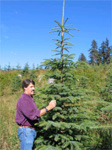 Testing
Tree Planting Provenance Standards– It’s Almost Rocket Science Testing
Tree Planting Provenance Standards– It’s Almost Rocket Science
“What trees can I plant?” is one of the first questions landowners ask when
presented with the option of tree planting as a means for reforestation. Tree
and Shrub Establishment Conservation Practice Standard 612 directs planners to
select native species with a local provenance ("provenance" is a French word
meaning “the local area you are from").
Florida
Requires
Windows Media Player

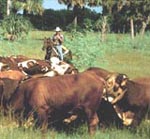 EQIP
Initiatives in the Sunshine State EQIP
Initiatives in the Sunshine State
According to Florida NRCS State
Conservationist Niles Glasgow, there
are many different initiatives that fall under the umbrella of EQIP.
Washington
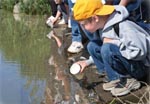 Classrooms
Become Hatcheries as Students Raise Salmon Classrooms
Become Hatcheries as Students Raise Salmon
Students across Washington are receiving the education of a salmon’s lifecycle by
raising fry in their classrooms for release into local rivers.
Connect to
NRCS' State
News,
Newsroom, and
News Releases!

State Conservationist
Honored
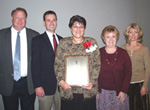 Indiana NRCS State Conservationist Jane Hardisty
was recently honored as the first natural resources graduate to receive the
Distinguished Alumni Award from Ball State University (BSU). Hardisty graduated
from BSU in 1974 with a bachelor's degree in natural resources, biology, and
geology. Indiana NRCS State Conservationist Jane Hardisty
was recently honored as the first natural resources graduate to receive the
Distinguished Alumni Award from Ball State University (BSU). Hardisty graduated
from BSU in 1974 with a bachelor's degree in natural resources, biology, and
geology.

 November
is American Indian Heritage Month November
is American Indian Heritage Month
In 1986, President Reagan designated November 23-30 as "American Indian Week."
Four years later, President Bush proclaimed the first National American Indian
Heritage Month. Each year since, U.S. Presidents have proclaimed November as
"American Indian Heritage Month."
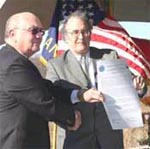 USDA
and DOD Sign Conservation Partnership Agreement USDA
and DOD Sign Conservation Partnership Agreement
USDA Natural Resources and Environment Deputy Under Secretary
Merlyn Carlson and Department of Defense Defense of Environment, Safety, and
Occupational Health Assistant Deputy Under Secretary
Alex Beehler
recently signed an agreement establishing a national partnership in conservation
efforts near military bases around the nation. The partnership will enable
greater efficiency in conservation efforts by both agencies through the sharing
of technical information and services.
Links…
NRCS news release
"USDA and DOD Sign Conservation Partnership Agreement" November 8, 2006
NRCS Conservation Programs
DOD's Environmental Use
Buffers Program
DOD's Readiness and Environmental Protection Initiative

Recycling
Agricultural Plastics Makes Environmental Sense
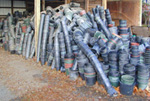 Petroleum-based
plastics are used for agricultural products such as pesticide
containers, silage bags, hay bale wrap and other packaging, mulch film,
irrigation materials including drip tape, greenhouse covers, and planting pots and trays. Currently most agricultural plastics are
disposed of on-farm by either burning or burying. Neither of these options is
desirable. By recycling, versus burning or burying, farmers and landowners
can improve air and water quality as well as provide plastic for recycling thus reducing embedded energy
consumption for the nation. Petroleum-based
plastics are used for agricultural products such as pesticide
containers, silage bags, hay bale wrap and other packaging, mulch film,
irrigation materials including drip tape, greenhouse covers, and planting pots and trays. Currently most agricultural plastics are
disposed of on-farm by either burning or burying. Neither of these options is
desirable. By recycling, versus burning or burying, farmers and landowners
can improve air and water quality as well as provide plastic for recycling thus reducing embedded energy
consumption for the nation.
The U.S. Department of Agriculture (USDA) prohibits discrimination in all its
programs and activities on the basis of race, color, national origin, age,
disability, and where applicable, sex, marital status, familial status, parental
status, religion, sexual orientation, genetic information, political beliefs,
reprisal, or because all or a part of an individual's income is derived from any
public assistance program. (Not all prohibited bases apply to all programs.)
Persons with disabilities who require alternative means for communication of
program information (Braille, large print, audiotape, etc.) should contact
USDA's TARGET Center at (202) 720-2600 (voice and TDD). To file a complaint of
discrimination write to USDA, Director, Office of Civil Rights, 1400
Independence Avenue, S.W., Washington, D.C. 20250-9410 or call (800) 795-3272
(voice) or (202) 720-6382 (TDD). USDA is an equal opportunity provider and
employer.
| | |


